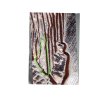These are two 1992 Canadian Nickels where I am suspecting that the die used to mint the coin on the left was retouched.
Coin specialists are telling me that the mint has not retouched/re-engraved dies since the 60's and it is impossible that the parallel lines (you see on the left picture) are engraving marks. The experts are classifying them as die scrapes caused by the finger feeder.
The montage illustrates my argument that an engraver repaired a die defect by extending the fur lines towards the log (shown using cyan lines). The parallel lines are on average approximately 4mils in width. For me, it is impossible for the finger feeder to cleanly scrape the back/tail/log junction at the depth of the last cyan line, without scratching the field of the die.
So, please help. I am asking for your expertise to either confirm or reject my hypothesis and provide your reasoning. Thank you.

Coin specialists are telling me that the mint has not retouched/re-engraved dies since the 60's and it is impossible that the parallel lines (you see on the left picture) are engraving marks. The experts are classifying them as die scrapes caused by the finger feeder.
The montage illustrates my argument that an engraver repaired a die defect by extending the fur lines towards the log (shown using cyan lines). The parallel lines are on average approximately 4mils in width. For me, it is impossible for the finger feeder to cleanly scrape the back/tail/log junction at the depth of the last cyan line, without scratching the field of the die.
So, please help. I am asking for your expertise to either confirm or reject my hypothesis and provide your reasoning. Thank you.















